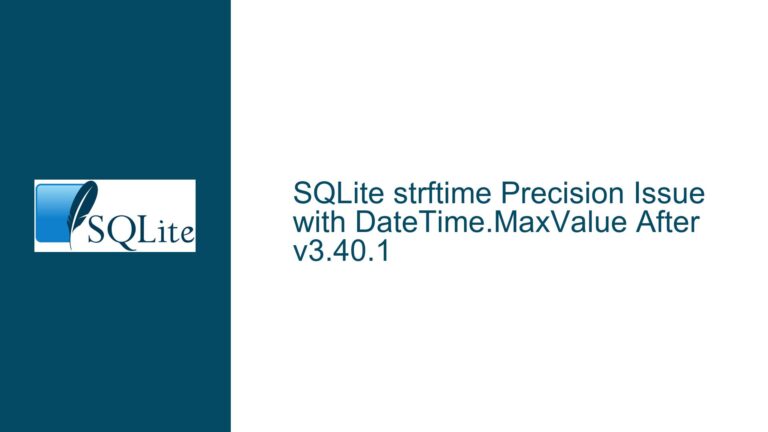Pivoting Long Lists into Wide Tables in SQLite: Challenges and Solutions
Transforming Long Lists into Wide Tables Using PIVOT (Crosstab) Functionality
Issue Overview
The core issue revolves around transforming a long list of data into a wide table format, commonly referred to as a pivot or crosstab operation. In SQLite, this transformation is not natively supported through a built-in PIVOT or crosstab function, unlike in some other database systems like PostgreSQL. The long list typically contains multiple columns, including grouping columns and fields that need to be pivoted into header rows. The goal is to reorganize this data so that specific values from one column become new column headers, and corresponding values from another column populate the cells under these new headers.
For example, consider a long list of sales data with columns for Year, Month, Product, and Sales. The desired wide table might have Year and Month as grouping columns, with Product values pivoted to become column headers, and Sales values filling the cells under each product header. This transformation is essential for creating summary reports, dashboards, or any scenario where a more compact, readable format is required.
The absence of a native PIVOT function in SQLite means that users must rely on alternative methods to achieve this transformation. These methods often involve complex SQL queries, the use of virtual tables, or even external scripting to manipulate the data. The challenge lies in implementing these solutions efficiently, especially when dealing with large datasets or when the pivot logic needs to be dynamic.
Possible Causes
The primary cause of this issue is SQLite’s design philosophy, which prioritizes simplicity and lightweight operation over the inclusion of advanced, specialized functions like PIVOT or crosstab. SQLite is often used in embedded systems, mobile applications, and other environments where resource constraints are a concern. As a result, it lacks some of the more sophisticated features found in larger database systems.
Another contributing factor is the nature of the data itself. Pivoting requires a clear understanding of the data structure and the relationships between columns. In some cases, the data may not be well-suited for pivoting, leading to complications during the transformation process. For instance, if the column intended to become the new headers contains a large number of unique values, the resulting wide table could become unwieldy and difficult to manage.
Additionally, the lack of a standardized approach to pivoting in SQLite means that users often have to reinvent the wheel, leading to inconsistent implementations and potential performance issues. This is particularly problematic when the pivot logic needs to be applied across multiple queries or when the data schema evolves over time.
Troubleshooting Steps, Solutions & Fixes
To address the challenge of pivoting long lists into wide tables in SQLite, several approaches can be considered. Each approach has its own advantages and trade-offs, and the choice of method will depend on the specific requirements of the task at hand.
1. Using Conditional Aggregation
One common method for pivoting data in SQLite is to use conditional aggregation. This approach involves using the CASE statement within an aggregate function to create new columns based on the values in the pivot column. For example, if you have a long list of sales data with columns for Year, Month, Product, and Sales, you can pivot the Product values into new columns using the following query:
SELECT
Year,
Month,
SUM(CASE WHEN Product = 'ProductA' THEN Sales ELSE 0 END) AS ProductA,
SUM(CASE WHEN Product = 'ProductB' THEN Sales ELSE 0 END) AS ProductB,
SUM(CASE WHEN Product = 'ProductC' THEN Sales ELSE 0 END) AS ProductC
FROM
SalesData
GROUP BY
Year, Month;
In this query, the CASE statement is used to create new columns (ProductA, ProductB, ProductC) based on the values in the Product column. The SUM function aggregates the Sales values for each product, and the GROUP BY clause ensures that the results are grouped by Year and Month.
This method is straightforward and works well for small to medium-sized datasets. However, it has limitations when dealing with a large number of unique values in the pivot column, as each value requires a separate CASE statement. This can lead to lengthy and repetitive queries, especially if the pivot logic needs to be dynamic.
2. Using Virtual Tables
Another approach is to use virtual tables, which allow you to create custom table structures that can be queried like regular tables. Virtual tables can be implemented using SQLite’s C API, which provides a way to define custom table behaviors and data sources. This method is more complex and requires programming skills, but it offers greater flexibility and can handle more sophisticated pivot scenarios.
To create a virtual table for pivoting, you would need to define a custom table module that implements the necessary logic for transforming the long list into a wide table. This module would need to handle the dynamic creation of columns based on the values in the pivot column, as well as the aggregation of data for each new column.
Once the virtual table is created, you can query it like any other table, and the pivot logic will be applied automatically. This approach is particularly useful when the pivot logic needs to be reused across multiple queries or when the data schema is subject to frequent changes.
3. Using External Scripting
For more complex pivot scenarios, or when the data is too large to handle efficiently within SQLite, you can use external scripting to perform the transformation. This approach involves exporting the data from SQLite, processing it using a scripting language like Python, and then importing the transformed data back into SQLite.
For example, you could use Python’s pandas library to read the long list from SQLite, pivot the data using the pivot_table function, and then write the resulting wide table back to SQLite. This method offers the most flexibility and can handle large datasets and complex pivot logic with ease. However, it requires additional setup and maintenance, as well as knowledge of the scripting language being used.
4. Using Common Table Expressions (CTEs)
Common Table Expressions (CTEs) can also be used to pivot data in SQLite. CTEs allow you to define temporary result sets that can be referenced within a query, making it easier to break down complex transformations into manageable steps. For example, you can use a CTE to first aggregate the data and then pivot it using conditional aggregation.
WITH AggregatedData AS (
SELECT
Year,
Month,
Product,
SUM(Sales) AS TotalSales
FROM
SalesData
GROUP BY
Year, Month, Product
)
SELECT
Year,
Month,
SUM(CASE WHEN Product = 'ProductA' THEN TotalSales ELSE 0 END) AS ProductA,
SUM(CASE WHEN Product = 'ProductB' THEN TotalSales ELSE 0 END) AS ProductB,
SUM(CASE WHEN Product = 'ProductC' THEN TotalSales ELSE 0 END) AS ProductC
FROM
AggregatedData
GROUP BY
Year, Month;
In this example, the AggregatedData CTE first aggregates the sales data by Year, Month, and Product. The main query then pivots the aggregated data using conditional aggregation. This approach can make the query more readable and easier to maintain, especially when dealing with complex pivot logic.
5. Using Dynamic SQL
For scenarios where the pivot logic needs to be dynamic, you can use dynamic SQL to generate the pivot query at runtime. This approach involves constructing the SQL query as a string based on the unique values in the pivot column and then executing the query using SQLite’s exec function.
For example, you could use a scripting language like Python to generate the SQL query dynamically based on the unique values in the Product column. The generated query would include a CASE statement for each unique product, and the resulting wide table would have columns for each product.
import sqlite3
# Connect to the SQLite database
conn = sqlite3.connect('sales.db')
cursor = conn.cursor()
# Get unique product values
cursor.execute("SELECT DISTINCT Product FROM SalesData")
products = [row[0] for row in cursor.fetchall()]
# Generate the pivot query
pivot_query = f"""
SELECT
Year,
Month,
{', '.join([f"SUM(CASE WHEN Product = '{product}' THEN Sales ELSE 0 END) AS {product}" for product in products])}
FROM
SalesData
GROUP BY
Year, Month;
"""
# Execute the pivot query
cursor.execute(pivot_query)
results = cursor.fetchall()
# Print the results
for row in results:
print(row)
# Close the connection
conn.close()
In this example, the Python script first retrieves the unique product values from the SalesData table. It then generates a pivot query that includes a CASE statement for each product and executes the query using SQLite’s exec function. This approach allows for dynamic pivoting based on the data, but it requires additional scripting and may not be suitable for all environments.
6. Using SQLite Extensions
Finally, you can consider using SQLite extensions that provide additional functionality, including pivot operations. While SQLite itself does not natively support pivoting, there are third-party extensions and libraries that can be used to achieve this functionality. These extensions often provide more advanced features and can simplify the process of pivoting data.
For example, the sqlite3-pivot extension provides a PIVOT function that can be used to pivot data directly within SQLite. This extension can be loaded into SQLite using the load_extension function, and it allows you to perform pivot operations with a simple SQL query.
-- Load the pivot extension
.load ./sqlite3-pivot
-- Perform the pivot operation
SELECT * FROM PIVOT(SalesData, 'Product', 'Sales', 'Year, Month');
In this example, the PIVOT function is used to pivot the SalesData table based on the Product and Sales columns, with Year and Month as the grouping columns. This approach provides a more straightforward way to perform pivot operations, but it requires the use of third-party extensions, which may not be suitable for all environments.
Conclusion
Pivoting long lists into wide tables in SQLite can be challenging due to the lack of native PIVOT or crosstab functionality. However, by using conditional aggregation, virtual tables, external scripting, CTEs, dynamic SQL, or SQLite extensions, you can achieve the desired transformation. Each method has its own advantages and trade-offs, and the choice of approach will depend on the specific requirements of your task. By understanding these methods and their implications, you can effectively pivot data in SQLite and create more readable and actionable summaries of your data.






